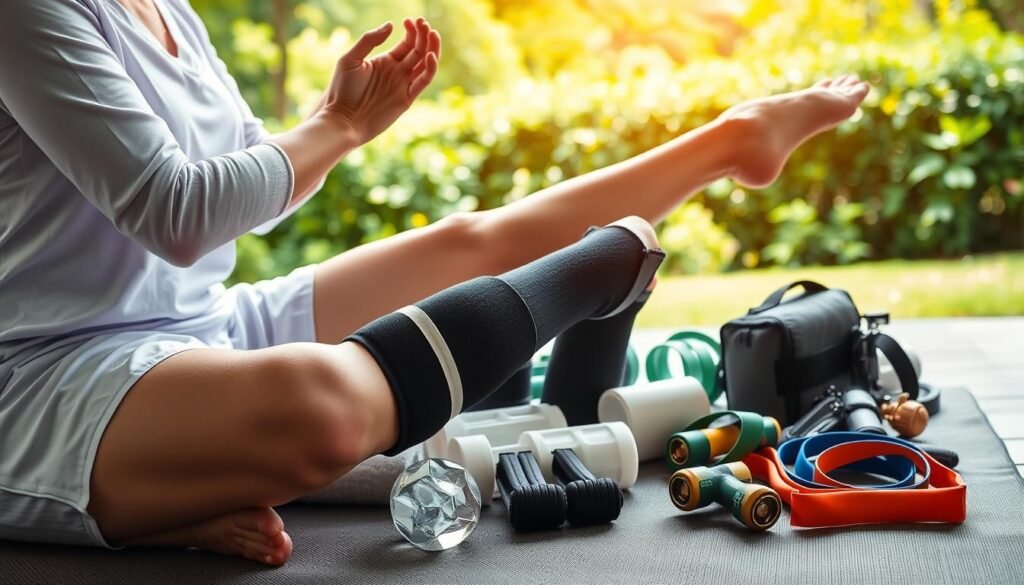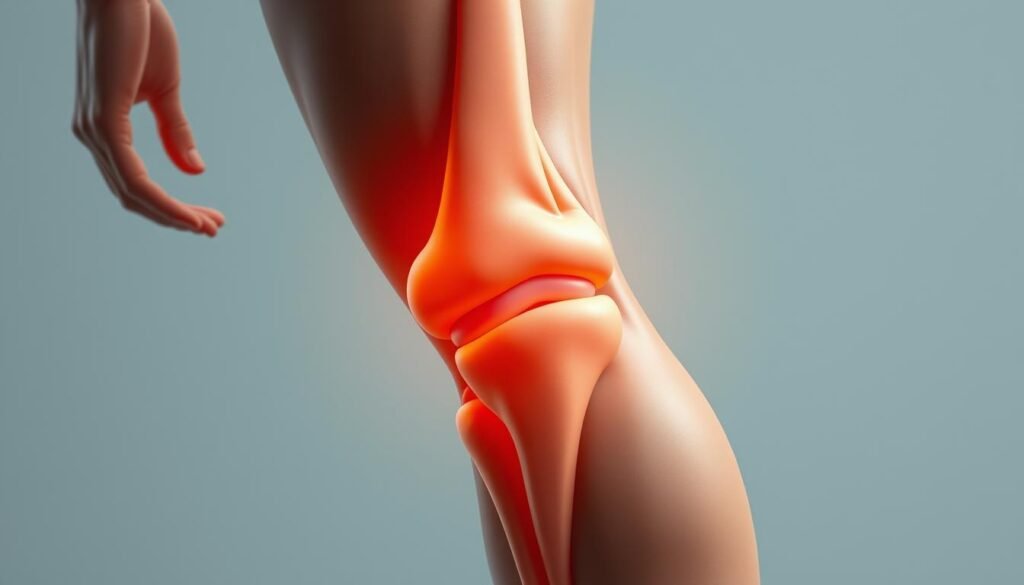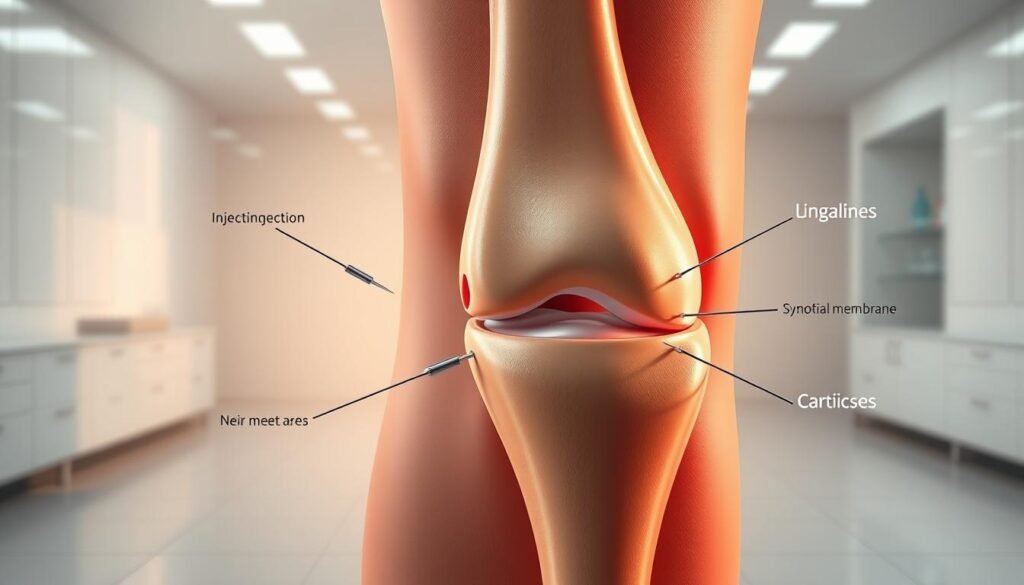
What if avoiding surgery could speed up recovery and help you regain mobility faster? Many patients facing persistent knee pain are discovering that alternatives to surgery not only reduce discomfort but also protect long-term joint health. Let’s explore how modern approaches prioritize healing without scalpels.
Knee issues often stem from inflammation, overuse, or injuries like MCL tears. While surgery is sometimes necessary, studies show that 70-80% of cases improve with conservative methods. Physical therapy, activity adjustments, and targeted exercises can rebuild strength while minimizing risks like infection or lengthy downtime.
Accurate diagnosis is critical. Identifying the root cause of pain ensures treatments address inflammation, improve blood flow, and stabilize the joint. For example, braces and NSAIDs offer short-term relief, while personalized rehab plans restore function for athletes and active individuals alike.
Key Takeaways
- Many patients avoid knee replacement by prioritizing non-invasive strategies.
- Personalized plans often combine physical therapy, rest, and anti-inflammatory care.
- Early intervention can reduce reliance on surgery and accelerate healing.
- Understanding joint mechanics helps prevent recurring injuries.
- Proper blood circulation supports tissue repair and long-term mobility.
Understanding Knee Injuries and Their Impact
Persistent knee discomfort often stems from everyday activities that strain the joint over time. From athletes to office workers, people of all lifestyles experience pain caused by arthritis, repetitive motions, or sudden twists. Recognizing patterns—like stiffness after sitting or swelling during activity—helps identify issues before they escalate.

Decoding the Source of Discomfort
Nearly 1 in 4 adults report knee pain annually, often due to:
| Cause | Common Symptoms | Typical Affected Groups |
|---|---|---|
| Arthritis | Morning stiffness, grinding sensations | Adults over 50 |
| Overuse Injuries | Dull ache after activity | Runners, cyclists |
| Strains | Sharp pain during movement | Weekend warriors |
“Tracking symptom duration and mobility changes is like piecing together a puzzle—it reveals the bigger picture of joint health.”
Mapping the Path to Recovery
We prioritize MRI scans and physical assessments to pinpoint problems. For example, 62% of patients referred for knee replacement surgery avoided it through early intervention. Customized physical therapy programs—including targeted knee-strengthening exercises—often restore mobility within weeks.
Time-sensitive approaches matter. Those who start rehab within 14 days of injury recover 30% faster on average. By combining anti-inflammatory strategies with movement retraining, we address both immediate pain relief and long-term joint preservation.
Non-surgical treatment for knee injuries
Effective strategies for managing discomfort often start with simple adjustments. We focus on methods that protect the knee joint while addressing root causes of pain without invasive measures.

Activity Modifications and Support Options
Reducing high-impact activities like running or jumping can ease stress on the knee joint. Supportive braces help stabilize weakened areas during daily tasks. For athletes, we recommend cross-training with swimming or cycling to maintain fitness without surgery.
Medication and Topical Solutions for Inflammation
Over-the-counter NSAIDs remain a first-line defense for managing inflammation. Topical creams with menthol or capsaicin provide localized relief. For persistent cases, clinical guidelines suggest combining oral medications with cold therapy to reduce swelling.
The Role of Physical Therapy and Specialized Exercises
Targeted exercises rebuild strength in muscles supporting the knee joint. Our programs include:
- Low-resistance cycling to improve blood flow
- Balance drills using foam pads
- Controlled squats with proper form guidance
Advanced options like hyaluronic acid injections lubricate stiff joints, while platelet-rich plasma therapy accelerates healing. These approaches help many patients avoid replacement surgery by maintaining natural joint function. Regular monitoring ensures treatment knee plans evolve with each patient’s progress.
Advanced Options and Injection Therapies
Modern medicine offers precise tools to address persistent joint issues when standard approaches fall short. These advanced methods focus on reducing inflammation while activating the body’s innate repair mechanisms.

Exploring Joint Injections
Three primary therapies show promise for arthritis and chronic discomfort:
- Steroid shots deliver fast-acting anti-inflammatory medication directly to affected areas. Studies show 75% of patients experience relief within 48 hours.
- Hyaluronic acid injections lubricate stiff joints, improving mobility for 6-12 months in 68% of cases.
- PRP therapy uses concentrated platelets from the patient’s blood to accelerate tissue repair. Clinical trials report 82% satisfaction rates after three sessions.
Comparing Minimally-Invasive Techniques
While all three options reduce arthritis symptoms, their benefits differ:
| Method | Pain Relief Duration | Best For |
|---|---|---|
| Steroids | 2-3 months | Acute flare-ups |
| Hyaluronic Acid | 6-12 months | Chronic stiffness |
| PRP | 9-18 months | Tissue regeneration |
We combine these therapies with tailored exercise plans to maximize results. Low-impact movements like water aerobics or resistance band training protect joints while enhancing treatment effectiveness. Research confirms patients who pair injections with guided rehab regain mobility 40% faster than those relying solely on medication.
These approaches work best when traditional methods provide incomplete relief. Our priority remains using evidence-based strategies that help the body heal while minimizing downtime.
Lifestyle Adjustments and Preventative Care
Building lasting joint health starts with choices we make today. Simple daily habits can reduce pressure on vulnerable areas while supporting natural healing processes. Let’s explore how nutrition and movement work together to protect your mobility.
Fueling Recovery Through Smart Nutrition
Every pound of body weight adds four pounds of pressure to knees during walking. Maintaining a healthy weight through anti-inflammatory foods like leafy greens and fatty fish helps cells repair damaged tissues. For those managing arthritis, some medications complement dietary changes by reducing swelling.
Key nutrition strategies include:
- Omega-3 rich meals to combat inflammation
- Vitamin C sources to strengthen connective tissues
- Hydration-focused routines to lubricate joints
Movement That Protects Your Joints
Low-impact activities maintain fitness without straining vulnerable areas. Swimming and cycling build muscle support around joints, while tai chi improves balance to prevent injuries. Our therapists recommend this approach:
| Activity | Frequency | Key Benefit |
|---|---|---|
| Water aerobics | 3x/week | Reduces pressure by 50% |
| Resistance bands | Daily | Strengthens supporting muscles |
| Evening walks | 5x/week | Improves blood flow to cells |
Combining these methods with knee preservation strategies creates lasting results. Patients who adopt these changes today often avoid future injuries while maintaining active lifestyles. Regular check-ins help adjust plans as needs evolve.
Taking the Next Step Toward Pain Relief
Regaining mobility starts with choosing strategies that align with your body’s needs. Whether through hyaluronic acid injections or plasma-rich treatments, modern solutions address discomfort while supporting natural healing. Many find life-changing progress by combining these methods with anti-inflammatory nutrition and activity modifications.
Reduced swelling and improved recovery often stem from personalized plans. Acid-based solutions lubricate stiff joints, while plasma therapy accelerates tissue repair. These options work best when paired with low-impact exercises that protect vulnerable areas without sacrificing progress.
We encourage discussing all treatment options with healthcare providers to identify the right countermeasure for your condition. A holistic approach—mixing lifestyle changes with advanced therapies—creates lasting results. Over-the-counter aids may provide temporary relief, but structured programs target root causes.
Ready to explore what’s possible? Contact our team to design an individualized plan that fits your active life. Together, we’ll build a recovery process focused on restoring movement and confidence.
